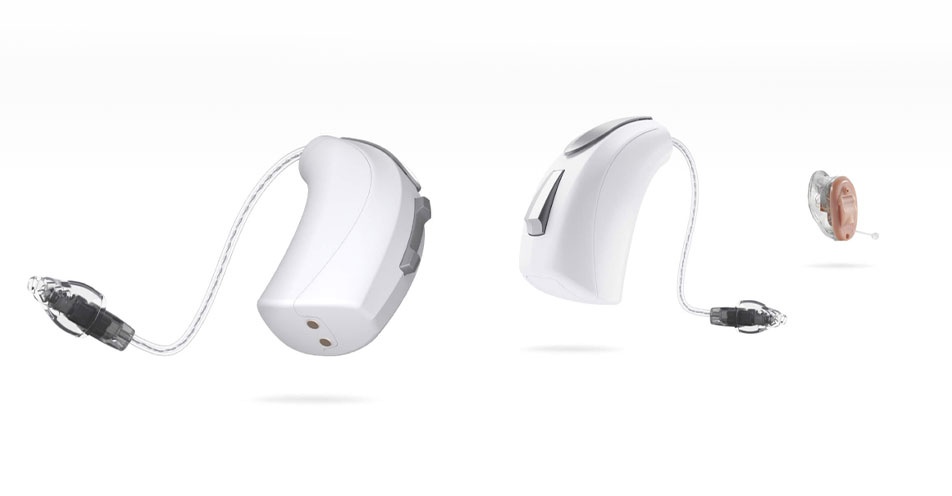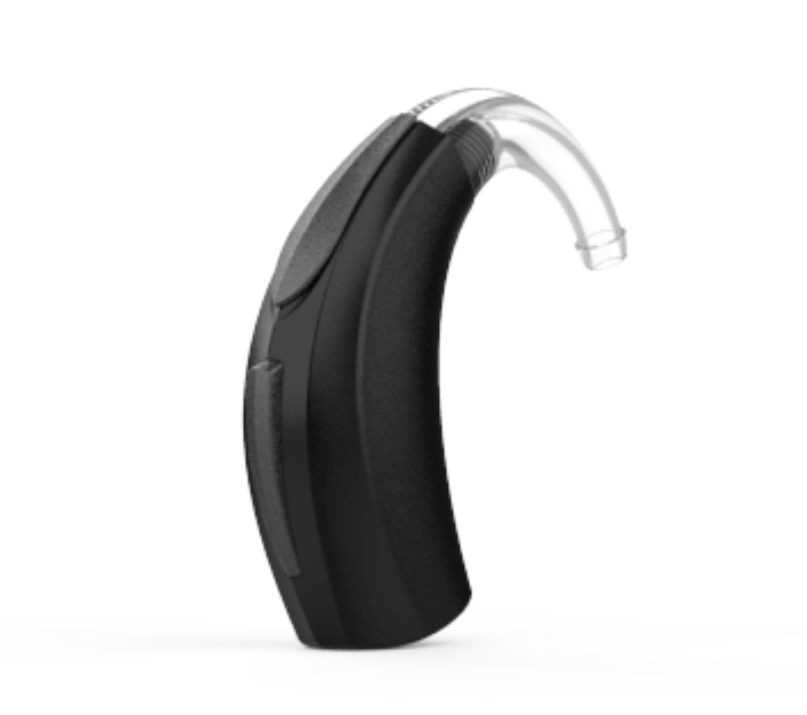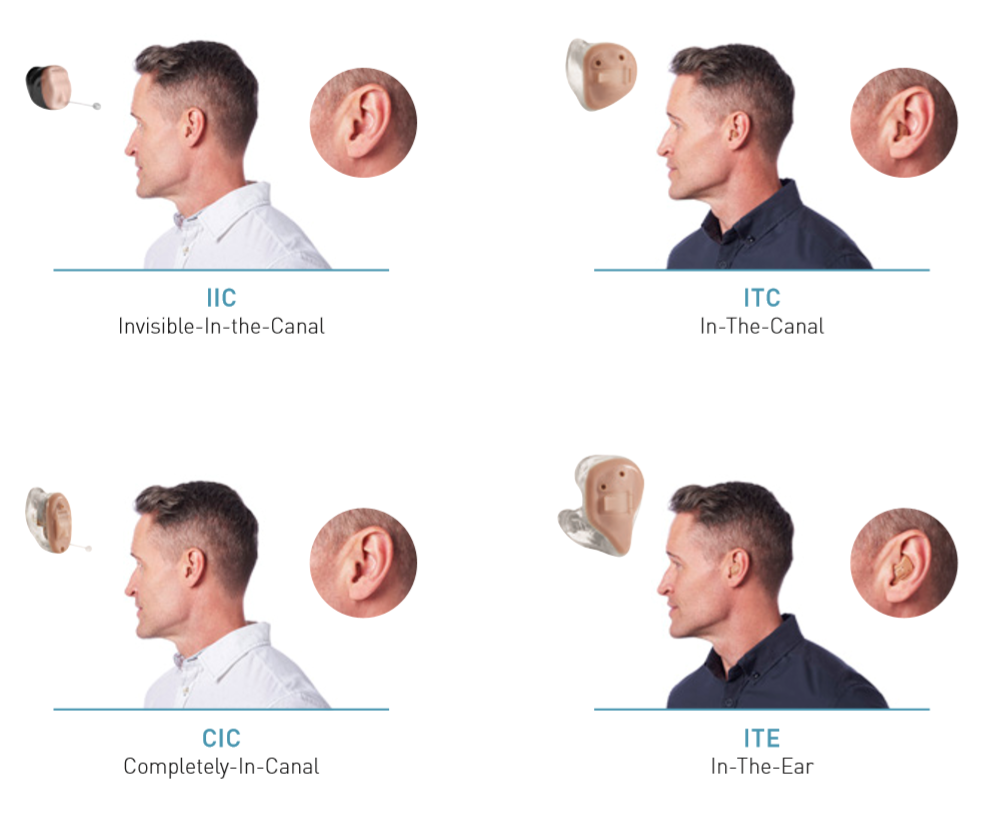Starkey Hearing Technologies is a Minnesota-based global hearing aid manufacturer. Having started as a one-man hearing aid repair shop in the late 1960s, Starkey began manufacturing its own hearing aids in the early 1970s. These days, Starkey sells hearing aids in over 100 different countries. It also owns several other noteworthy hearing aid brands (Audibel, MicroTech, and NuEar).
As one of the “Big Six” hearing aid manufacturers (which includes Widex, Oticon, ReSound, Signia, Starkey, and Phonak), Starkey has built a reputation for being one of the handful of expensive brands sold at hearing clinics and audiology offices. With retail prices averaging between $2,162 and $9,002 a pair, a new set of Starkeys will cost you about the same as a second-hand vehicle.
This begs the question:
Is the high price of Starkey hearing aids worth it when more affordable, high-quality alternatives are available?
In this guide, we’ll provide a detailed look at Starkey – its technology, models, pricing, and quality – so you can decide whether to invest in this hearing aid brand. We’ll also introduce you to a dramatically more affordable, high-quality alternative to Starkey, the MDHearing VOLT MAX.
Please use the following links to navigate this guide:
- General Overview of Starkey Hearing Aids
- Starkey Hearing Aid Styles and Technology Bundles
- Starkey User Reviews
- An Affordable High-Quality Alternative to Starkey: MDHearing
General Overview of Starkey Hearing Aids
Starkey has a long-standing reputation for innovation in hearing aid technology with the following noteworthy achievements:
- The first to create an in-the-canal hearing aid that conceals itself completely in the ear.
- The first to create a digital, customizable, in-the-canal hearing aid.
- The first to explore advanced background reduction technology.
- The first to develop waterproof hearing aid technology.
Here’s a sample of the styles in Starkey’s hearing aid lineup:
Image Source: Starkey Hearing Technologies Website
With its current offerings, Starkey has kept up to date with modern hearing aid advancements. The manufacturer offers varying levels of tech through different tech bundles. These tech bundles include:
- Livio (Livio, Livio AI, and Livio Edge AI): Offers AI-powered sound setting and background noise adjustment technology, sound streaming, and some of the most advanced hearing aid tech features on the market today (Livio and Livio AI circa 2018).
- Halo and Halo IQ: Offers iPhone and Android app connectivity, sound streaming, and other hearing aid technology that is now several years old. (Halo IQ circa 2017). These hearing aids may be difficult to find without going through an intermediate seller.
- Muse and Muse IQ: Offers app connectivity and sound streaming through an external adaptor and other hearing aid features that are now several years old (Muse IQ circa 2016). These hearing aids may be difficult to find without going through an intermediate seller.
- Z Series: Offers app connectivity and sound streaming through an external adaptor, high-frequency voice technology, and advanced features that are now several years old (circa 2015). These hearing aids may be difficult to find without going through an intermediate seller.
The availability of the above-referenced tech bundles depends on which Starkey hearing aid style you choose, as you’ll see in the following section.
Starkey Hearing Aid Styles and Technology
Here are some of the models and technologies you’ll find in the current Starkey lineup:
Starkey Receiver-in-Canal Styles (RIC)
Receiver-in-canal hearing (RIC) aids feature a hearing aid body that rests behind the ear, while a small wire connects to a microphone in the ear canal.
Starky’s Livio family of hearing aids includes RIC style devices. Livio, Livio AI, and Livio Edge AI hearing aids use a variety of advanced digital hearing aid technologies to improve sound clarity in complex, noisy listening situations. The Livio AI and Livio Edge AI models have additional artificial intelligence computing technology that automatically adjusts sound and listening settings for better sound clarity and voice comprehension in different background noise situations.
Image Source: Starkey Hearing Technologies Website
The Livio RIC models may include the following technologies from the “Livio” tech bundles (Livio, Livio AI, and Livio Edge AI), depending on which model and features you select:
- Automatic settings adjustments: Auto-adjustments based on external sound conditions through artificial intelligence technology.
- Natural hearing clarity: Improved sound quality for more “natural hearing” in different environments.
- Rechargeable: Rechargeable hearing aid technology with 24-hours of use per charge.
- App control: Adjust your hearing aid volume and other settings from the smartphone app while you’re wearing and using the hearing aids.
- Bluetooth connectivity: Bluetooth device connections for streaming voice calls and music from your smartphones, tablets, and TVs.
- Wind and machine noise: Wind noise and background machine noise reduction.
- Thrive Hearing Control: Lifestyle management features via the Thrive App, which includes a brain activity tracker that measures your daily active listening and social engagement in addition to fitness tracking. These are connected to the app.
- Telehealth Service: In-app hearing treatment and emergency medical features. These allow you to connect with a remote hearing care specialist for care recommendations. The app can even detect if you have fallen and automatically call for emergency assistance if you don’t deactivate the alert.
- Note-taking and translation: In-app technology that can take speech sounds from 27 different foreign languages and translate it into English text in real-time. The app can also record your voice sounds and turn them into text notes.
- Find my hearing aid: Helps you locate your hearing aids when you lose them.
How much do they cost? Starkey prices range from $2,162 to $9,002 per pair on average. Contact an audiologist that sells Starkey hearing aids for more accurate pricing.
Starkey Behind-the-Ear Styles (BTE)
Starkey’s different model families (like Livio, Halo, Muse, and Z Series) also offer behind-the-ear (BTE) style hearing aids. BTE hearing aids feature a clear plastic tube (not a wire), which directs sounds from the hearing aid body into a clear plastic dome that goes into the ear. Unlike RICs, the receiver and all other tech components of a BTE are housed in the hearing aid body behind the ear.
Here’s what a typical Starkey BTE hearing aid looks like:
Image Source: Starkey Hearing Technologies Website
Depending on which model and features you select, Starkey BTEs may include the following tech bundles:
- Livio and Livio AI technology: Refer to the above section on Starkey RICs to see the features available with Livio and Livio AI technology.
- Halo IQ technology: The Halo tech bundle includes “Made for iPhone” and Android device technology. Halo connects your hearing aids with a smartphone app to stream music and voice sounds from your smartphone (Starkey TruLink 2.4 GHz wireless tech). You can also control your hearing aids with your smartphone. It includes other features to reduce background noise, reduce feedback whistles, and let you customize your hearing aid settings. Halo technology also offers water-shielding for extra protection.
- Z Series technology: The Z Series technology bundle is compatible with a device adapter (SurfLink for 2.4 GHz streaming), which allows you to connect your hearing aids to your smartphone for sound and music streaming features. Z Series technology also includes tinnitus therapy, digital background noise control, automatic gradual adjustments as sound conditions change, special tech to improve the clarity of high-frequency voices from women and children, feedback reduction, moisture protection, and more.
- Muse IQ technology: The Muse technology bundle is very similar to the Z Series except it doesn’t offer the high-frequency voice assistance feature. The Muse IQ also includes SurfLink for 2.4 GHz sound streaming from your devices and TV.
How much do they cost? Starkey prices range from $2,162 to $9,002 per pair on average. Contact an audiologist that sells Starkey hearing aids for more accurate pricing.
Picasso Custom-Fit In-the-Ear Style (ITE)
Starkey’s “Picasso” custom-fit technology refers to its line of in-the-ear hearing aids. These devices include larger styles that rest in the bowl of your ear but are still visible and progressively smaller models. The smallest Picasso is an invisible-in-the-ear (IITE) model that hides completely in the ear canal.
Here’s what the Starkey Picasso line looks like:
Image Source: Starkey Picasso Brochure
Not all Starkey Picassos offer the same technology. Depending on the model and tech features you select, a pair of Picassos may include the following:
- Custom-molded: A custom-molded fit to the interior shape of your ear (all models).
- Automatic sound adjustments: Automatically and gradually adapts to the changing sound conditions you find yourself in.
- Discrete to totally invisible: Picassos include discrete in-the-ear hearing aids (which is still visible) and smaller models, one of which is so small that it hides completely in the ear canal.
- Bluetooth compatible (Surflink): Bluetooth connectivity for live wireless streaming of phone calls and music from various devices like smartphones, TVs, music players, and tablets via the “Surflink” external adaptor.
- Advanced background noise reduction: Technology for sound and voice clarity in a variety of listening environments.
- Feedback reduction: Reduces “whistling” noises.
- High-tech sound clarity features: Reduces sound distortion and improves the quality of music.
- Multiflex Tinnitus relief: Features that use soothing background sounds to mask tinnitus symptoms.
How much do they cost? Starkey prices range from $2,162 to $9,002 per pair on average. Contact an audiologist that sells Starkey hearing aids for more accurate pricing.
Starkey User Reviews
We’ve collected a mix of positive and critical user reviews so you can get a better sense for the good and bad of Starkey hearing aids. What we found was an even mix of positive and critical reviews. This tells us that it’s difficult to predict whether you’re going to be satisfied or dissatisfied with the product.
Positive User Reviews
I think they work very well. The app gives you a great deal of control over the environment, including a one-touch button to limit background noise, which works very well. I have mine pre-programmed for Normal, Restaurant, Auditorium (for group meetings in a large room), plus it has the ability to adjust direction, background noise, loudness, wind. You also can add your own custom programs for your own listening environment. The app tells you how much battery power is left. I typically get 5-6 days depending on how much I use them to listen to music or am on my iPhone with them. And yes, it streams directly from the iPhone to both ears. Are they "great" for recorded music? No – headphones are better, BUT, they are fine to just stream music and answer your phone if you don't have or want to use an earpiece. I used to have problems in a group of people – no more. Also issues in a courtroom – no more. In an auditorium, with a presenter – no more. Expensive, but I think worth it." – Reviewer on HearingTracker
The hearing aid is excellent. It was a game-changer from the ones I had before. Sadly, One was defective after a short time. I have replaced them with a newer version of the Livio extra ai. They are doing a very good job across the board in helping my hearing loss." – Richard on HearingTracker
What I love about it: I can listen to books or podcasts with pretty good clarity. Music is not quite as good. My provider gave me a Music Setting which works well, from the little testing I have done. That is, I do not stream the music but listen to an outside source. Live music is too loud and I have to usually remove the hearing aid since I can't turn it down low enough to not hurt in the ambient music volume. When the commercials in the movie theater come on, I have to yank it out of my ear, then turn it off until the movie starts. I get occasional loud feedback noises. I'm completely deaf in my right ear. My first hearing aid was a basic bi-cross. I lost one h/a so I moved into this single, more advanced hearing aid which has more technology that I can use. I turn on the microphone in my iPhone and put it on the table to hear my dinner partners. In a crowd, it doesn't work very well; it's a swell of the noise of conversation and cutlery - impossible. I'd certainly be at a disadvantage without this hearing aid. The batteries last at least 4 days, if not more." – Reviewer on HearingTracker
Critical User Reviews
I had Phonak for ten years and they were fine. I decided with all the new technology that is out today I should upgrade my hearing aids. I have tried Starkey and Oticon. The Starkeys are constantly whistling in my ear… I’m almost done with my thirty-day trial with the Starkeys, and at this point, I am not sure what to do. I know that hearing aids are not perfect and can help to a certain point, but when I put them on and don't hear any difference in the sound of the television, something is wrong. Do audiologists favor certain brands more than others? For some reason, I think the person I am working with now favors Starkey. Do they get a kickback from certain companies?" – Reviewer on HearingTracker
Not well. I really don’t like them. I think there must be something that works better. I don’t like the way they sound and they make hearing the phone and TV almost impossible." – Reviewer on HearingTracker
The aids seem to have problems with the electronics. They have been sent back to the provider twice in two years. The last time they were completely replaced. I have no issue with the customer service, that has been just fine. My issue is with the problems that have caused me to work with customer service to begin with. It has also been very difficult to arrive at proper settings for my hearing loss, even though it is only moderate." – Reviewer on HearingTracker
An Affordable High-Quality Alternative to Starkey: MDHearing
Starkey Hearing Technologies certainly produces some of the most technologically-advanced hearing aids on the market – and their high prices reflect this. From a quality perspective, Starkey has an excellent reputation among audiologists for building a reliable hearing aid, and as you’ll note in the user reviews, if your Starkey hearing aid breaks under warranty, they’ll send you a replacement.
However, we found just as many dissatisfied Starkey customers as happy ones. This makes us wonder if the high price of Starkey is actually worth it. If customers are still complaining of poor sound quality, difficulty listening to music and the TV, and a hard time in noisy environments – even with all of these tech features – paying extra for Starkey technology isn’t always worth the price.
Here’s what we suggest: Before you settle on spending between $2,162 to $9,002 for a pair of Starkeys, we suggest you give MDHearing a try. MDHearing provides FDA-registered, medical-grade hearing aids that cost thousands of dollars less than the hearing aids sold at hearing clinics. We keep our costs down by selling direct to consumers – no office visit or doctor’s appointment required.
Best of all, MDHearing comes with a 100%, money-back satisfaction guarantee. So if it’s not the right match, you can always return it and try something else.
Try the MDHearing VOLT MAX Risk-Free!
For potential Starkey customers, we recommend the MDHearing VOLT MAX, which currently sells for less than $1,000 for a pair. The VOLT MAX offers some of the latest background noise reduction and feedback reduction technology. It also connects to the MDHearing smartphone app which allows you to check your hearing and automatically adjusts your hearing aids according to your results.
Here’s a complete list of features in the MDHearing VOLT MAX:
- App control: Adjust your hearing aid volume and program settings from the smartphone app while you’re wearing and using the hearing aids.
- Automatic sound adjustments: Automatically adapts to the changing sound conditions you find yourself in.
- Dual directional microphones: Features dual directional microphones that focus on the most important voice sounds in front of you, so you can hear conversations in a noisy environment.
- Four listening environment settings: Offers four different settings to accommodate your listening environment.
- Feedback cancelation: Offers advanced feedback reduction to control “whistling” sounds.
- Complex listening environments: Helps you understand voices in complex listening situations such as church sermons, group conversations, parties, and restaurants.
- Custom adjustments according to your professional hearing test: If you send your hearing test to MDHearing, our on-staff audiologists can remotely adjust your hearing aids to fit your exact hearing loss profile remotely via the MDHearing app on your smartphone.
- Price: The VOLT MAX sells for under $1,000 on the MDHearing website.
- 100% money-back guarantee: Each VOLT MAX comes with a 100%, money-back satisfaction guarantee.
Want to see if MDHearing hearing aids will work for you? Take our quick and easy online hearing test and get your results instantly.
TAKE ONLINE HEARING TEST





